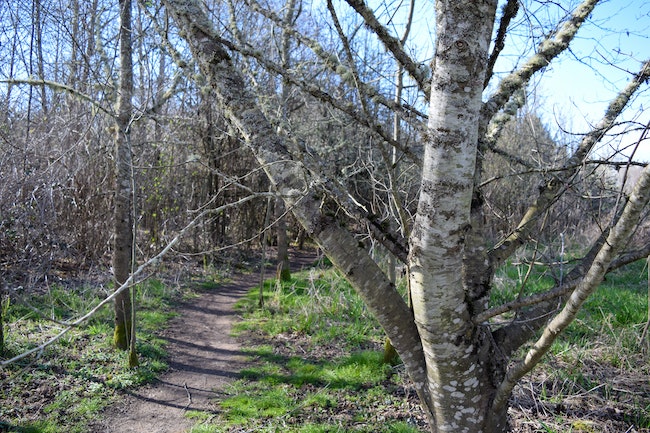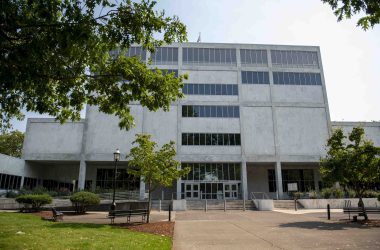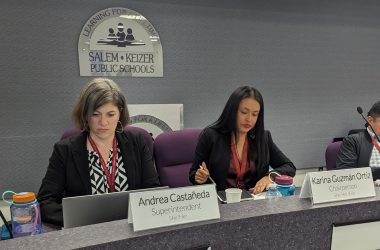 A tree in Minto-Brown Island Park. (Saphara Harrell/Salem Reporter)
A tree in Minto-Brown Island Park. (Saphara Harrell/Salem Reporter)
About a quarter of Salem is covered by trees as the result of a decade-long city effort that hasn’t shaded every neighborhood equally.
The city recently released its most recent Urban Tree Canopy Assessment, showing that each neighborhood saw increases albeit at varying levels.
Patricia Farrell, parks and natural resources planning manager, said the city has been really focused on investing money into its tree canopy – “not just planting, but making sure they’re maintained.”
Last year, the city spent more than $1 million to plant, maintain and remove city trees, according to the assessment. Farrell said planting contracts are paid from the city’s stormwater funds. Salem can also use money from the gas tax for trees, she said.
Trees have numerous economic, social and environmental benefits, from cleaner air to lower stress. They enhance the beauty of a place, create habitat for wildlife and provide green infrastructure that increases in value over time.
In 2010, the city conducted an assessment that found Salem’s urban tree canopy was largely unchanged at 18% from 2001 to 2009.
Based on an analysis of high-resolution imaging and mapping done in 2018, Salem was 24% trees and has 34% more that could support trees. The study noted that some of the gains recorded in tree canopy could be attributed to better mapping.
The largest gain was in Minto-Brown Island Park which added 174 acres as a result of restoration areas growing and counting former tree plantations.
The city’s next goal is to hit 28% tree canopy. Farrell said the city is looking for partnerships, such as with schools and churches, to plant trees.
“The encouraging thing is it seems like we’re on a good trajectory to keep growing the canopy,” she said.
UNEQUAL GAINS
Most of the gains were in wealthier neighborhoods in south and west Salem. North and east Salem saw the lowest canopy increases between 2% and 4% over a decade.
The Lansing neighborhood saw the lowest increase citywide, registering a quarter of the gains southwest Salem made.
 Percentage of urban tree canopy gain in the last decade. (Source: Salem’s 2019 Urban Tree Canopy Assessment)
Percentage of urban tree canopy gain in the last decade. (Source: Salem’s 2019 Urban Tree Canopy Assessment)
Councilor Chris Hoy said one of the reasons he ran for city council was to make sure his ward, which represents east Salem, was represented.
“We’re often overlooked in these kinds of endeavors,” he said.
Hoy said there’s a gap in providing services to those who don’t have the resources to buy and maintain trees.
“We want people to plant trees, but yet in my neighborhood they’re working paycheck to paycheck,” he said. “Trees are kind of a luxury for some folks.”
Hoy said he wants to explore a partnership that would encourage private landowners to plant trees. However, he said the city will have to get creative with east Salem because the area is so built out.
“I’m just frustrated that we haven’t made more progress out here in east Salem,” Hoy said. “I want to make sure that that doesn’t continue in the next decade.”
 Urban tree canopy by census block. (Source: Salem’s 2019 Urban Tree Canopy Assessment)
Urban tree canopy by census block. (Source: Salem’s 2019 Urban Tree Canopy Assessment)
Median household income by census block in 2018 adjusted dollars. (Source: U.S. Census Bureau 2014-2018)
Farrell said part of the discrepancy is the zoning and the age of north and east Salem neighborhoods. Large commercial zones like on Northeast Lancaster Drive leave a lot of acreage paved over.
“It’s just tougher to find those planting areas along streets,” Farrell said.
In 2014, Salem released a Community Forestry Strategic Plan with a focus on planting on city properties and in neighborhoods with the lowest tree cover.
Back then, the Northgate and Southeast Mill Creek neighborhoods had the lowest canopy at 9% each.
Farrell said the challenge is investing public dollars on private property.
“We don’t necessarily have control over what happens to those trees in the future,” she said.
Paul Ries, an urban forestry professor at Oregon State University, said Salem isn’t an outlier in the ways that tree canopy is distributed.
In 2015, three researchers with the U.S. Forest Service found a correlation between the socioeconomic status of urban residents in the Pacific Northwest and the abundance of urban forest – richer areas had more trees.
A study published in January found that neighborhoods that were subject to discriminatory, race-based housing practices a century ago are now hotter in temperature than other areas. Redlining was a practice in the 1930s that rated neighborhoods to help mortgage lenders know which areas of a city were considered risky.
Ries, whose been involved in urban forestry for 35 years, said conversations around equity in urban planting have been happening for more than a decade but it has been studied more now.
“I would point out that the environmental literacy that you’re seeing is much greater than it used to be,” he said.
Ries said organizations like Friends of Trees, a nonprofit which plants trees in cities around Oregon, are making strides in addressing the historic inequality of planting in urban areas.
“It’s not just tree planting. They’re actually enhancing the community, giving neighbors and residents the ability to volunteer to improve their own community,” he said.
FRIENDS OF TREES
The city contracts with Friends of Trees to organize plantings throughout the city. Last year, volunteers with Friends of Trees planted 172 large trees and 5,645 small trees and shrubs in Minto Island Conservation Area, Judson Middle School, Bill Riegel Park, McKay School Park, and Cascades Gateway Park.
Farrell said most of the Friends of Trees plantings have been directed in neighborhoods with less canopy.
The group’s first project in Salem was at Hoover Elementary School in 2013.
 A Friends of Trees planting at Hoover Elementary in 2013. (Courtesy/Friends of Trees)
A Friends of Trees planting at Hoover Elementary in 2013. (Courtesy/Friends of Trees)
Another group, Treecology, plants trees in road rights-of-way and reached 208 trees last year.
The city’s recent urban canopy assessment said Salem’s trees provide $80 million in annual benefits for things like air quality, stormwater reduction and carbon sequestration.
Ries said the “economic, environmental and social benefits to trees in our cities, it’s not always understood or appreciated by people.”
Trees can provide clean air and water, impact the heating and cooling costs for homeowners and increase the value of homes.
“For every dollar we spend on trees we usually get between three, four, five dollars back in terms of the services the tree gives us,” Ries said.
REDUCE HEAT ISLAND
Research has shown that trees provide health benefits like lower blood pressure, and can reduce the urban heat island effect, areas without trees that have significantly higher temperatures.
A study published in 2019 found that cities with a tree canopy cover of 40% or more were cooler. The study said planting efforts shouldn’t occur only in areas where tree cover was already high.
“Climate adaptation efforts must also consider the social and environmental (in)justice issues embedded within many cities. A history of class and racial inequality and oppression has led to considerable inequalities in access to green space and environmental amenities in contemporary cities,” the study read.
Salem’s community forestry strategic plan established six goals which included protecting and enhancing the tree canopy, increasing education and outreach, and developing a Community Forestry Management Plan.
The city hasn’t established a management plan but is likely to after hiring a new urban forester this year, Farrell said.
LABORATORY FOR CLIMATE CHANGE
Kristin Ramstad manages the urban forestry program for the Oregon Department of Forestry, which works with cities on the Tree City USA program. Salem was the first city in Oregon to join in 1976.
Ramstad said Salem was ahead of other cities with its canopy survey in 2010.
“Nowadays many cities are very aware of the urban heat island effect and the fact that trees can lessen that. As always, it’s a question of where the trees are placed and what type of trees are used,” she said.
Ramstad said the most effective tree canopy comes from Douglas firs and sequoias, but they can’t be planted everywhere because they grow large and can block views. A sequoia seedling can take nearly two years to reach maturity.
She said maple trees are popular for canopy projects because they were a swamp species accustomed to having low oxygen around their roots. In Salem, about one-third of the tree cover is provided by maples. In the early days of urban planning, they were able to survive high soil compaction.
Ramstad sees urban forests as a testing ground for what climate change’s impacts will look like in neighborhoods and city parks.
“In urban forests because cities are environments that have been highly manipulated by humans, it’s also kind of a laboratory in advance of climate change,” she said. “You can kind of see what happens in situations where trees have less water.”
 A tree in Minto-Brown Island Park on a foggy morning. (Saphara Harrell/Salem Reporter)
A tree in Minto-Brown Island Park on a foggy morning. (Saphara Harrell/Salem Reporter)
STREET TREE INVENTORY
Farrell said in the past the city looked at easy targets, finding places to plant in public parks and using that as a stepping stone to increase the canopy.
“When you start looking at street trees in some of the more developed areas, especially in downtown, it’s harder to increase canopy because it’s one tree here, one tree there,” she said.
That’s because some planting strips are too narrow or have underground utilities.
“We try to invest as much as we can every summer to try to get some better data, but nobody has that as their one job to go around and find spots,” Farrell said.
Part of the city’s outreach will focus maintaining trees on private property, like teaching residents to avoid topping trees or indiscriminately cutting branches to stubs.
“We definitely want to improve the outreach about how to take care of trees,” Farrell said. “A lot of times we see people hire companies and they top the trees; one of the worst things you can do to your trees. People don’t realize that’s not an acceptable pruning method.”
GROWTH DESPITE DEVELOPMENT
Of all the available space to plant in the city, 44% is found in residential areas. The tree canopy assessment said the greatest opportunity for future canopy expansion is in medium density residential areas, which contain a quarter of the plantable areas in Salem.
In Salem, the areas with the lowest canopy cover are the state fairgrounds at 10%, and the Oregon State Hospital and Oregon State Penitentiary at 13%.
The areas with the highest canopy cover are southwest (41%) and south central (36%).
Areas with the most room for trees are off limits, such as the prison or McNary Field Airport.
A 2010 comparison of cities similar to Salem in size and climate found that Hudson, Ohio, and Nashville, Tennessee, had markedly higher percentages of trees, 44% and 43% respectively.
Correction: The urban forestry manager with ODF is Kristin Ramstad. An earlier version misstated her last name.
Have a tip? Contact reporter Saphara Harrell at 503-549-6250, [email protected] or @daisysaphara.









